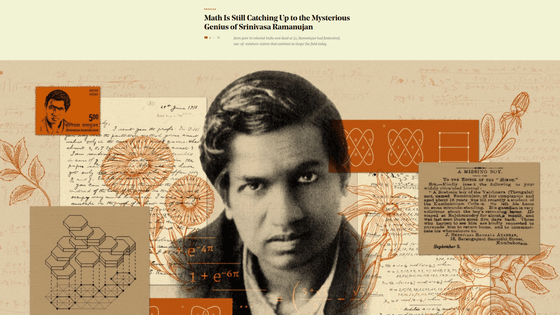The research findings of the Indian genius mathematician Ramanujan, who died at the age of 32, are still used in various fields today.

by
Indian mathematician Srinivasa Ramanujan is known for creating over 3,900 identities and equations in his short life of 32 years, earning him the nickname 'The Magician of India.' Ramanujan's numerous mathematical discoveries not only amazed the mathematical world of his time, but also continue to have a great influence on modern mathematicians.
Srinivasa Ramanujan Was a Genius. Math Is Still Catching Up. | Quanta Magazine
https://www.quantamagazine.org/srinivasa-ramanujan-was-a-genius-math-is-still-catching-up-20241021/

Ramanujan was born in 1887 to a poor Brahmin family in Kumbakonam, Thanjavur district, Tamil Nadu, South India. Due to his poverty, he was unable to receive a formal education during his childhood. However, at the age of 15, his encounter with a collection of mathematical formulas called the '
After studying various kinds of numerical properties and patterns on the basis of his handbook on pure mathematics, Ramanujan was awarded a full scholarship to study at his local Government Arts College in 1904, but failed every subject except mathematics and dropped out within a year.
Ramanujan continued his research as a self-taught mathematician, working as a mathematics teacher and eventually securing a job as a clerk at the Madras Port Trust in 1912. He continued his mathematical research, publishing some of his results in Indian journals, and sending letters to some British mathematicians with the results of his work, hoping to get them published in a more prestigious and widely read publication.


One famous anecdote about Ramanujan is when Hardy told him that the number of the taxi he was riding in was '1729,' to which Ramanujan immediately replied, 'The smallest positive integer that can be expressed in two ways as the sum of the cubes of two positive integers.' From this episode, which shows Ramanujan's genius, '1729' is called
After four years of research in England, Ramanujan returned to India in 1919 and died at the young age of 32 in 1920, but he achieved many things in his short life. One of these was the ' Rogers–Ramanujan identity ,' which links complex infinite sums and infinite products.

The Rogers-Ramanujan identity is still used today in a wide range of fields. In the 1970s, Australian physicist Rodney Baxter discovered that the Rogers-Ramanujan identity plays an important role in analyzing lattice gas models as a statistical mechanical approach to studying phase transitions .
Rutgers University mathematicians James Lepowski and Robert Wilson also proved that the Rogers-Ramanujan identity can also be used in representation theory . Their discovery gave birth to a field called ' vertex operator algebras ,' and the Rogers-Ramanujan identity has also been used in string theory and in group theory to prove the ' monstrous moonshine ' myth.
Furthermore, it has been proven that the Rogers–Ramanujan identity can also be applied to the study of Markov chains, which are sequences of random variables that satisfy P(Xt+1∣Xt,Xt−1,…,X1)=P(Xt+1∣Xt), and is now used to model a variety of phenomena.
Ramanujan's work has also influenced the field of 'algebraic geometry,' which studies curves and surfaces defined by polynomial equations. French mathematician Hussein Murtada used his work to understand the structure of curve intersections and acute angles, called 'singular points.' 'Ramanujan is someone who can imagine things that people like me cannot imagine. But the development of new fields of mathematics gives us the possibility of finding research results that Ramanujan could find only by imagination. That's why mathematics is so important,' Murtada said.

Related Posts:
in Science, Posted by log1r_ut







